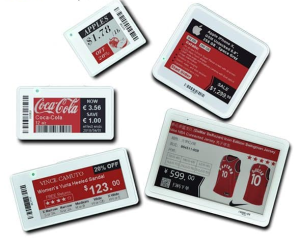Over the past ten years, pricing strategies have undergone a remarkable transformation, thanks to the advent and evolution of electronic pricing technologies.
- Farewell to Static Price Tags: Gone are the days of manually changing price tags and wrestling with paper labels. Electronic pricing has bid farewell to the static world of traditional pricing methods. In their place, we now have dynamic Electronic Shelf Labels (ESLs) that empower retailers to update prices effortlessly and in real-time.
- Agility and Flexibility: With the introduction of electronic pricing, retailers have gained unprecedented agility and flexibility. No longer constrained by the arduous task of individually updating prices on each item, store owners can now make changes swiftly across their entire inventory. This newfound flexibility allows retailers to respond swiftly to market trends, competitive pricing, and promotional strategies.
- Precision and Accuracy: Electronic pricing has revolutionised the accuracy of price management. Retailers no longer have to worry about pricing errors or outdated information on product labels. ESLs provide precise and up-to-date pricing information, ensuring a seamless shopping experience for customers and reducing potential pricing disputes.
- Enhanced Customer Experience: The integration of electronic pricing has significantly enhanced the overall customer experience. ESLs allow retailers to display additional information beyond price, such as product details, nutritional facts, special offers, and even customer reviews. This wealth of information empowers shoppers, enabling them to make informed purchasing decisions.
- Personalisation and Targeted Pricing: One of the most notable changes in electronic pricing over the last decade is the ability to personalise pricing strategies. Retailers can now implement targeted pricing based on factors such as customer loyalty, purchasing behaviour, or even real-time demand. This personalised approach fosters customer loyalty and increases customer satisfaction, leading to long-term business growth.
- Competitive Advantage: Electronic pricing has become a key differentiator for retailers seeking a competitive edge in the market. By leveraging ESLs and dynamic pricing strategies, retailers can optimise pricing based on factors such as demand, inventory levels, and competitor prices. This agility allows businesses to stay ahead of the curve, attract customers with competitive pricing, and maximise profitability.
- Seamless Integration with Retail Systems: Over the past decade, electronic pricing has become more seamlessly integrated with other retail systems. ESLs can now communicate directly with inventory management systems, POS systems, and pricing optimisation software. This integration streamlines pricing processes, minimises errors, and ensures consistency across all channels, whether in-store or online.
- Eco-Friendly Practices: Electronic pricing has also brought forth eco-friendly practices in the retail industry. By eliminating the need for paper labels and reducing waste, ESLs contribute to sustainability efforts. Retailers can proudly embrace a greener approach to pricing, aligning their businesses with the growing demand for environmentally conscious practices.

As we reflect on the changes electronic pricing has brought about in the past ten years, it’s evident that the retail landscape has undergone a remarkable evolution. From static price tags to dynamic ESLs, retailers have embraced agility, accuracy, personalization, and eco-friendliness in their pricing strategies. By leveraging the power of electronic pricing, retailers can stay ahead of the curve, provide exceptional customer experiences, and drive business growth.
So, buckle up and get ready to embrace the future of retail pricing, where innovation and customer-centric strategies continue to shape the industry. The journey has just begun, and the possibilities are endless. Let’s make the most of electronic pricing to revolutionize the way we shop and redefine
#ElectronicShelfLabels #ESL #FutureofRetail
